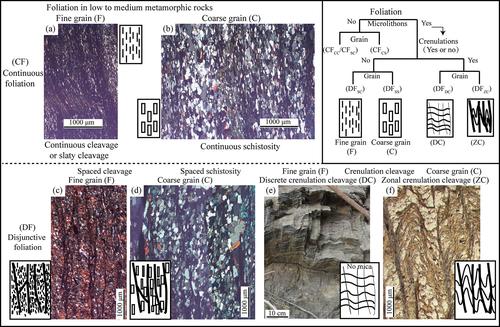当前位置:
X-MOL 学术
›
Acta Geol. Sinica Engl. Ed.
›
论文详情
Our official English website, www.x-mol.net, welcomes your feedback! (Note: you will need to create a separate account there.)
Formation of Foliations and their Related Minerals from Diagenetic to Medium-grade Metamorphic Rocks: A Case Study of the Hongyanjing and Liao-Ji Backarc Basins, China
Acta Geologica Sinica-English Edition ( IF 3.3 ) Pub Date : 2021-07-05 , DOI: 10.1111/1755-6724.14790 Zhonghua TIAN 1 , Fei WEN 1 , Fulai LIU 1 , Haozhong ZHU 2 , Zhanghuang YE 3
Acta Geologica Sinica-English Edition ( IF 3.3 ) Pub Date : 2021-07-05 , DOI: 10.1111/1755-6724.14790 Zhonghua TIAN 1 , Fei WEN 1 , Fulai LIU 1 , Haozhong ZHU 2 , Zhanghuang YE 3
Affiliation

|
Deciphering the relationship between polyphase tectonic foliations and their associated mineral assemblages is significant in understanding the process from diagenesis to low-/medium-/high-grade metamorphism. It can provide information related to strain, metamorphic conditions and overprinting relationships and so help reveal the tectonic evolution of orogenesis. In this study, we predominately focus on the formation of foliations and their related minerals, as developed in two separate basins. First of all, two stages of axial plane cleavages (S1 and S2) were recognized in the Hongyanjing inter-arc basin, the formation of the S1 axial plane cleavage is associated with mica rotation and elongation in mudstones in the local area. The pencil structure of S2 formed during the refolding phase, the minerals in the sedimentary rocks not changing their shape and orientation. Secondly, in the Liao-Ji backarc basin, foliations include diagenetic foliation (bedding parallel foliation), tectonic S1 foliation (secondary foliation or axial plane cleavage of S0 folding) and crenulation cleavage (S2). The formation mechanism of foliation changes from mineral rotation or elongation and mineral solution transfer in S1 to crystal-plastic deformation, dynamic recrystallization and micro-folding in S2. Many index metamorphic minerals formed from low-grade to medium-grade consist of biotites, garnets, staurolite and kyanite, constituting a typical Barrovian metamorphic belt. Accordingly, a new classification of foliation is presented in this study. The foliations can be divided into continuous and disjunctive foliations, based on the existence of microlithons, detectable with the aid of a microscope. Disjunctive foliation can be further sub-divided into spaced foliation and crenulation cleavage, according to whether (or not) crenulation (micro-folding) is present. The size of the mineral grains is also significant for classification of the foliations.
更新日期:2021-08-29



























 京公网安备 11010802027423号
京公网安备 11010802027423号